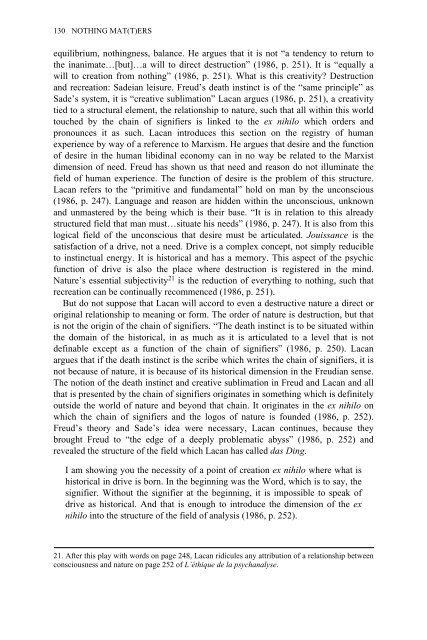Nothing Mat(t)ers: A Feminist Critique of Postmodernism
Nothing Mat(t)ers: A Feminist Critique of Postmodernism
Nothing Mat(t)ers: A Feminist Critique of Postmodernism
You also want an ePaper? Increase the reach of your titles
YUMPU automatically turns print PDFs into web optimized ePapers that Google loves.
130 NOTHING MAT(T)ERS<br />
equilibrium, nothingness, balance. He argues that it is not “a tendency to return to<br />
the inanimate…[but]…a will to direct destruction” (1986, p. 251). It is “equally a<br />
will to creation from nothing” (1986, p. 251). What is this creativity Destruction<br />
and recreation: Sadeian leisure. Freud’s death instinct is <strong>of</strong> the “same principle” as<br />
Sade’s system, it is “creative sublimation” Lacan argues (1986, p. 251), a creativity<br />
tied to a structural element, the relationship to nature, such that all within this world<br />
touched by the chain <strong>of</strong> signifi<strong>ers</strong> is linked to the ex nihilo which ord<strong>ers</strong> and<br />
pronounces it as such. Lacan introduces this section on the registry <strong>of</strong> human<br />
experience by way <strong>of</strong> a reference to Marxism. He argues that desire and the function<br />
<strong>of</strong> desire in the human libidinal economy can in no way be related to the Marxist<br />
dimension <strong>of</strong> need. Freud has shown us that need and reason do not illuminate the<br />
field <strong>of</strong> human experience. The function <strong>of</strong> desire is the problem <strong>of</strong> this structure.<br />
Lacan ref<strong>ers</strong> to the “primitive and fundamental” hold on man by the unconscious<br />
(1986, p. 247). Language and reason are hidden within the unconscious, unknown<br />
and unmastered by the being which is their base. “It is in relation to this already<br />
structured field that man must…situate his needs” (1986, p. 247). It is also from this<br />
logical field <strong>of</strong> the unconscious that desire must be articulated. Jouissance is the<br />
satisfaction <strong>of</strong> a drive, not a need. Drive is a complex concept, not simply reducible<br />
to instinctual energy. It is historical and has a memory. This aspect <strong>of</strong> the psychic<br />
function <strong>of</strong> drive is also the place where destruction is registered in the mind.<br />
Nature’s essential subjectivity 21 is the reduction <strong>of</strong> everything to nothing, such that<br />
recreation can be continually recommenced (1986, p. 251).<br />
But do not suppose that Lacan will accord to even a destructive nature a direct or<br />
original relationship to meaning or form. The order <strong>of</strong> nature is destruction, but that<br />
is not the origin <strong>of</strong> the chain <strong>of</strong> signifi<strong>ers</strong>. “The death instinct is to be situated within<br />
the domain <strong>of</strong> the historical, in as much as it is articulated to a level that is not<br />
definable except as a function <strong>of</strong> the chain <strong>of</strong> signifi<strong>ers</strong>” (1986, p. 250). Lacan<br />
argues that if the death instinct is the scribe which writes the chain <strong>of</strong> signifi<strong>ers</strong>, it is<br />
not because <strong>of</strong> nature, it is because <strong>of</strong> its historical dimension in the Freudian sense.<br />
The notion <strong>of</strong> the death instinct and creative sublimation in Freud and Lacan and all<br />
that is presented by the chain <strong>of</strong> signifi<strong>ers</strong> originates in something which is definitely<br />
outside the world <strong>of</strong> nature and beyond that chain. It originates in the ex nihilo on<br />
which the chain <strong>of</strong> signifi<strong>ers</strong> and the logos <strong>of</strong> nature is founded (1986, p. 252).<br />
Freud’s theory and Sade’s idea were necessary, Lacan continues, because they<br />
brought Freud to “the edge <strong>of</strong> a deeply problematic abyss” (1986, p. 252) and<br />
revealed the structure <strong>of</strong> the field which Lacan has called das Ding.<br />
I am showing you the necessity <strong>of</strong> a point <strong>of</strong> creation ex nihilo where what is<br />
historical in drive is born. In the beginning was the Word, which is to say, the<br />
signifier. Without the signifier at the beginning, it is impossible to speak <strong>of</strong><br />
drive as historical. And that is enough to introduce the dimension <strong>of</strong> the ex<br />
nihilo into the structure <strong>of</strong> the field <strong>of</strong> analysis (1986, p. 252).<br />
21. After this play with words on page 248, Lacan ridicules any attribution <strong>of</strong> a relationship between<br />
consciousness and nature on page 252 <strong>of</strong> L’éthique de la psychanalyse.

















